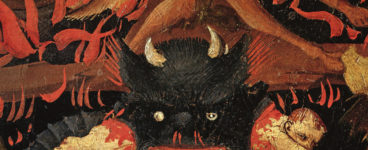‘He is synonymous with bloody sacrifice, scheming, false idols, lies, cunning tests, death and brutality, fire and screaming, the animalistic, and a struggle for dominance and dominion.’
Satan, Dracula, Sauron, Lord Foul, Darth Vader. The motif of the Satanic Dark Lord is ever-present in science fiction and fantasy, a malign intelligence seeking to thwart the Chosen One. In this study, prize-winning author A J Dalton considers how our understanding and characterisation of Satan has developed over time. In this extract, Dalton lays out one of the earliest uses of Satan as a literary character.
Extract taken from The Satanic in Science Fiction and Fantasy
By A. J. Dalton
Published by Luna Press Publishing
A close study of the history of Satan as a literary character thus allows us to understand the changing values and relationships of society. It also helps us understand how science fiction and fantasy are a reflection of, and direct comment upon, the moral, spiritual and philosophical condition and realities of their society. Without such an understanding and appreciation of Satan and SFF, I would argue, we are far lesser readers and far lesser individuals.
2.1 The Dark Lord and the white knight
It may surprise some to learn that Satan does not appear as a personification of evil in the Old Testament (OT) of the Bible (c.400BC). The serpent in the Garden of Eden is never named as Satan or described as any sort of supernatural entity. Indeed, rather than being a character’s name, the original Hebrew term ‘satan’ is a generic noun meaning ‘adversary’ (Kelly, 2006). Of the 27 uses of this noun in the OT, 17 of them are entirely generic/non-specific references to ‘the satan’ (it is unclear whether the agency is angelic, human or otherwise), seven more refer specifically to human beings, and two (including 2 Samuel 24) refer to an Angel of Yaweh acting on God’s behalf. The remaining reference in 1 Chron 21 simply references ‘a satan’ in a repeat of the story (told in Samuel) of David being punished by the Angel of Yaweh.
If we get any sense at all of Satan as a single, named character from the OT, it is as an angel of God’s celestial court carrying out the sacred tasks of God’s will. Far from being banished to some burning hell, Satan is one of heaven’s glorious representatives, honoured with the role of testing the worthiness of humans and punishing transgressors. Satan, therefore, acts as a divine prosecutor, only ‘adversarial’ in that he is an advocate of divine-will-as-the-law.
It is not until the New Testament (NT), approximately five hundred years later, that we have Satan as the distinct and named ‘devil’ with which modern audiences will be more familiar. This later version of Satan is diametrically opposed to the will of God, is as monstrous as it is seductive, represents sin in all its guises and only has a malign intent towards humankind.
With the increased characterisation of Satan’s nature in the NT, we also have an increased amount of description of his physical manifestation(s). It is the NT that claims the serpent in the OT’s Garden of Eden to be one of Satan’s avatars, and he is also described variously as ‘an enormous red dragon with seven heads and ten horns and seven crowns’, ‘a dragon that can spew water like a river’, ‘the beast’, a demon who can possess humans, one who can mark the heads and hands of his followers and ‘a thorn in the flesh’ (Biblica, 1978).
Therefore, the move from OT to NT sees Satan go from holy agent to a being who is entirely demonic in both behaviour and appearance. We must wonder what has happened in the five hundred years between the writing of the OT and NT to cause this ideological shift in representation. A closer examination reveals that the NT makes certain telling references and gives us some clues. In the Book of Revelation, Jesus instructs John of Patmos:
‘To the angel of the church in Pergamon write:
These are the words of him who has the sharp, double-edged sword. I know where you live – where Satan has his throne. Yet you remain true to my name. You did not renounce your faith in me, not even in the days of Antipas, my faithful witness, who was put to death in your city – where Satan lives.
(Biblica, Revelation 2: 12-13)
It appears that particular problems had occurred for the Christian faith in the city of Pergamon, and that these problems were due to an evil intent or ethos personified in Satan. By understanding what happened to the Christian priest Antipas, and the politics surrounding his death, we will see that the character of Satan was actually used to ‘demonise’ all those who were not Christian. This construction of Satan, then, was the product of the Christian faith engaging in a form of caricature-based political propaganda.
Pergamon was an ancient Greek city in what is now eastern Turkey. During the time of Antipas, who was executed in 92AD, the city was governed by Rome and was a regional and political capital. It was the site of one of Christianity’s seven major churches in Asia Minor, but also had major temples dedicated to the Greco-Egyptian god Serapis (Osiris twinned with Apis), to Athena twinned with Zeus, as well as to several other Greco-Roman gods and even to the Roman emperor himself. The city was also home to a famous school of medicine (where the renowned Greek doctor Galen himself practised) dedicated to the god of healing Asclepius, whose symbol was the snake. Purportedly, Antipas, whose name translates as ‘against all’, was killed by pagan priests and the followers of Serapis for refusing, when tested, to declare the Roman emperor as ‘lord and god’ above all (Renner, 2010). The manner of Antipas’s death is well documented: he was placed inside a life-size metal statue of a bull (the Brazen Bull had been previously gifted to the city by King Attalus, 241-197BC) and a fire was set beneath it; the screams of his death would have echoed inside the statue and sounded as if the bull was bellowing; the god was thereby brought to ‘life’ by the human sacrifice. Scholars such as Renner (2010) believe that the Brazen Bull would have been located upon the Great Altar of Zeus (the throne of Satan mentioned in Revelation) – an altar which took the form of a magnificent set of marble stairs and colonnades surrounded by a frieze (the battle between the Giants and the Olympian gods for supremacy of the cosmos) – atop the acropolis of Pergamon. From there, the public execution could be better seen and heard by all those in the city.
With Pergamon described as the home of Satan, its temples described as Satan’s throne, and the murderous attack on the priest of Christianity representing the action by which the devil ‘lives’, Satan becomes the personification of all pagan or non-Christian religions and all physical and political attacks upon Christianity. He is synonymous with bloody sacrifice, scheming, false idols, lies, cunning tests, death and brutality, fire and screaming, the animalistic, and a struggle for dominance and dominion. In terms of physical representation, he takes on the horns of a bull and the forked tongue of a snake. References to the bull might come from Apis the bull god, Zeus as a bull, or the golden calf of Exodus. The forked tongue of the snake, on the other hand, might relate to Asclepius (whose healers interfered with God’s will by way of their arcane arts), or the snake upon the god statue at the temple of Serapis as the Egyptian symbol of rulership and power, or yet again the snake in the Garden of Eden, or the ancient serpent that is the dragon. Finally, we see that the place over which he presides is a place of horror, torture, unholy spectacle and the public witnessing, endorsement or celebration of both sinful and sacrilegious acts. It is the exact opposite of the Kingdom of Heaven; it is literally hell-on-earth. It is not a place of ‘light’ (for Jesus is ‘the light of the world’, in John 8); rather, it is a place of darkness and the fires of punishment.
The Satanic in Science Fiction and Fantasy by A. J. Dalton is published by Luna Press Publishing, priced £12.99.
ALSO IN THIS ISSUE

 David Robinson Reviews: How Britain Ends
David Robinson Reviews: How Britain Ends
‘This is a consistently thought-provoking and well-argued book, and yet the more I read it, the more …

 The Satanic in Science Fiction and Fantasy
The Satanic in Science Fiction and Fantasy
‘He is synonymous with bloody sacrifice, scheming, false idols, lies, cunning tests, death and bruta …













